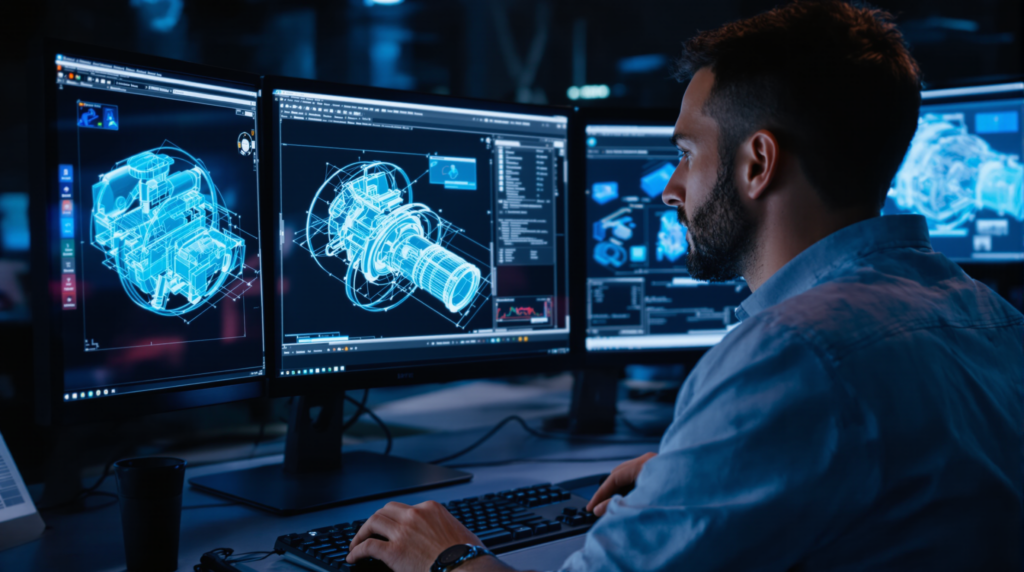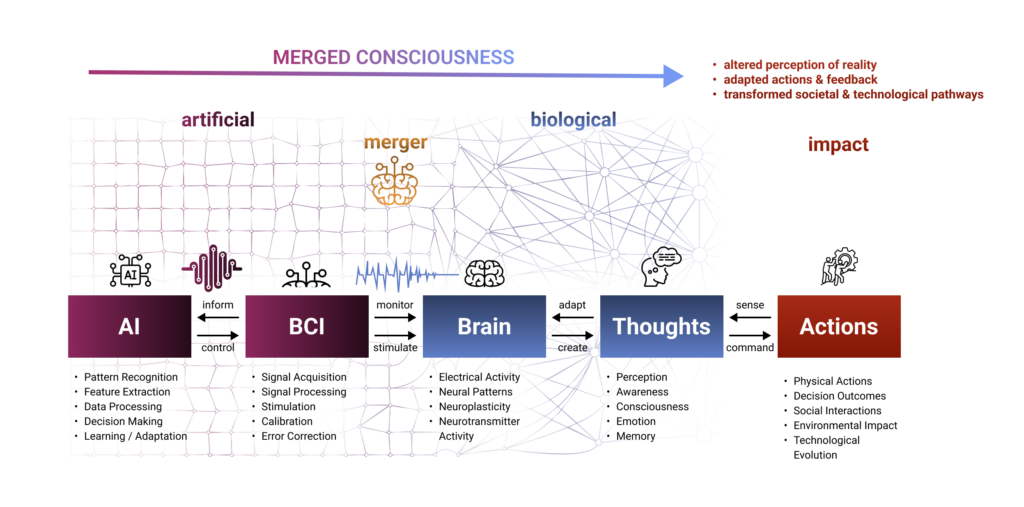Brain-computer interfaces (BCIs) have captured global attention, particularly since humanity’s uber-entrepreneur Elon Musk jumped on the bandwagon by founding Neuralink Corporation in 2016. Herein, I explore the already existing interface between humans and computers which, thanks to one of the brain’s most astonishing properties, has augmented our minds for decades already.
The possibilities the most modern BCIs offer are beyond revolutionary: they range from curing the incurable to augmenting humans to unprecedented levels of functionality — they are pushing the neural frontier. The advances in BCIs are powered by ever-improving AI algorithms and computing capabilities making progress in this field wholly unpredictable. Alas, these overwhelming opportunities come with serious ethical, societal, and economic risks. This article will tell a story about the advent of BCIs, their opportunities and risks, and the convergence of mind and machine toward merged consciousness. Finally, it will outline how we must prepare to ensure human autonomy and how policymakers can safeguard our future. Before that let’s briefly talk about our brains and why they are so astonishing.
Neuroplasticity and neurofeedback: how machines augment the mind
I decided to spend this winter in a warmer climate so that I could focus on improving my golf swing, training on my bike, and my professional endeavors away from the dread of Northern Europe. Navigating my new surroundings wasn’t a big deal, Google and Apple Maps guided me in my car or while working out on my gravel bike. At first, the apps were my constant guides, but after a few days, I didn’t need them anymore. I knew the main routes and where to avoid congestion with my car and the most exciting paths to speed along with my workout bike. The apps taught me through a human-computer feedback loop — feedback from the apps created new neural connections in my brain. What would have taken weeks without computers, I accomplished in days thanks to computer augmentation! So, how does a computer augment the brain without physical connectivity? The answer lies in the brain’s incredible adaptability — neuroplasticity.
Neuroplasticity is the brain’s ability to reorganize itself by forming new neural connections enabling us to adapt and learn. How do we learn? We learn by trial and error, feedback from our surroundings and our brain teaches us what and what not to do, e.g. don’t touch the hot stove, sugar is pleasant, detergent isn’t, picking this up will invoke mum’s anger and so on. This response to our actions — so-called neurofeedback — facilitates learning, the formation of neural connections. Meanwhile, there is clear scientific evidence for this: In “The Brain That Changes Itself”, Norman Doidge highlights the work of Dr. Merzenich, a neurologist, with patients suffering from tinnitus. Using neurofeedback and targeted auditory retraining, the therapy successfully altered the brain’s maladaptive neural activity patterns responsible for the condition. Medical evidence, including brain scans, showed a reduction in overactive neural pathways demonstrating the power of neuroplasticity for recalibrating the brain.
Ultimately, that is what the navigation apps have done with me: They gave me (neuro-)feedback on my navigation which accelerated the process of me internalizing my new surroundings — the human-computer interface in action! Computer augmentation isn’t limited to navigating new surroundings: in my professional work, I utilize computer simulations to understand complex systems. By interpreting simulation outputs, I understand these systems better in a shorter period of time; yet again what would have taken years without computers, I can accomplish in days with the help of the silicon machines. The same is true for, students learning new skills on Coursera or Udemy, holidaymakers brushing up on their language skills on Babbel or Duolingo, or engineers using computer-aided design (CAD) — see photo below. Thomas Malone refers to this as “superminds”, people collaborating create intelligent systems that are more intelligent than the sum of their parts; meanwhile, computers not only facilitate this collective intelligence by enabling easy information exchange but also contribute to the system by providing information that is used as feedback1.

These examples highlight a simple yet profound point: computers have been augmenting the human mind for decades, they give us feedback that enables us to form new neural connections more rapidly. Computers facilitate neuroplasticity through neurofeedback. Even without direct connections to the brain, learning and decision-making are facilitated, and computers have become integral to how we navigate the world, learn, and create! The collective intelligence of humans collaborating was converted to a supermind by computers. While they have long been part of our cognitive toolkit, the gap between humans and computers is narrowing faster than ever — mind and machine are converging.
The human-machine interface: a shrinking gap
Not long ago, a computer was something in an office or in certain homes. Since the development of the first real smartphone, the iPhone, most of us have carried a mini computer with us at all times. While these systems remain separate from our physical bodies, the gap is narrowing rapidly. Wearables like smartwatches or fitness trackers have brought us closer to the realm of computers; they monitor functions such as heart rate, heart function, blood oxygen levels, sleep patterns, and more. All this comes with significant benefits as we can monitor our health or sports performance while receiving feedback on it. Again, we can improve our health or sports performance based on input from computers. Personally, I own a smartwatch, EEG breast strap, bike computer and sensors that allow me to monitor my training and observe short- and long-term improvements. The system is also safeguarding me, e.g. when cycling a steep ascent, the system warns me when my heart rate goes into a dangerous zone. However, these clearly beneficial possibilities come with clear data privacy concerns as all the data are submitted to the cloud and analyzed by the providers’ AI. These data privacy concerns were and are addressed successfully2,3.
Things are getting interesting when we directly interact with our brain: Non-invasive devices such as Muse and Mendi have made neurofeedback treatment available at home. Again, these devices are connected to a smartphone and provide the data to the service provider’s cloud. These devices are unidirectional — i.e. they cannot affect our brain, just read some of its signals.
Bidirectional and invasive BCIs have been in use in medicine since the 1990s, Deep Brain Stimulation (DBS) for instance is a blessing for people suffering from Parkinson’s disease. While primarily stimulating the brain and alleviating Parkinson’s symptoms instantaneously, modern DBS systems can also record neural activity for adaptive responses that improve symptom relief. Notably, progress is rapid in this area and one specific device has received significant media coverage and will hence serve as an example — Neuralink.
Neuralink aims to create a seamless BCI capable of both recording and stimulating neural activity to treat neurological disorders, restore sensory and motor functions, and eventually enhance cognition and communication. Unlike medical DBS, which typically uses 4-8 electrodes for broad stimulation, Neuralink employs up to 1,024 flexible, high-precision electrodes to enable detailed, bidirectional communication with individual or small groups of neurons, allowing for significantly more complex and scalable applications —that’s more than100 times the touch points with the brain! Neuralink is hence the prime example that human and computer are converging.
Still, Neuralink isn’t the only player on the field: Synchron’s Stentrode is developing a BCI that is inserted into the body via the vascular system and hence doesn’t require direct brain surgery. This method will take away the major hurdle of brain surgery and consequently broaden access to the technology. Next to medical applications, consumer-focus applications are now envisioned: Companies like Emotiv Systems are developing noninvasive EEG headsets for gaming, education, and personal wellness, allowing users to monitor and control their cognitive states. Neurable and NextMind are integrating BCIs into virtual and augmented reality, enabling thought-based control of digital environments for entertainment and smart home interactions. These developments signal a growing trend where BCIs are becoming tools for everyday consumer use.
We’re not just carrying computers; we’re becoming one with them. Picture a world where your brain is not just augmented but co-evolves with AI, where your daily decisions are subtly influenced by an algorithm’s input.
BCIs combine the marvels of human neuroplasticity with cutting-edge AI and computational power. The once-clear boundary between man and machine is fading, the mentioned feedback loop is tightening! While tech advances are critical, the key ingredient for this symbiosis is the described malleability of the human brain, neuroplasticity.
Neuroplasticity and BCIs: a synergy between technological and biological marvels
As discussed, our brains are not static; they’re like clay, shaped by our upbringing, our social interactions, our education, and so on. Moreover, they are reshaped daily by our subjective experiences, qualia, and recently — on humanity’s time scale — by the tools of technology. This is something medical practitioners have understood for quite some time.
Maxwell Maltz, in his 1960s book “Psycho-Cybernetics,” argues that our minds can be programmed for success by reworking subconscious patterns. Through his experience as a plastic surgeon, Maltz observed that merely removing a physical disfigurement often did not alleviate the psychological burden associated with it; one also had to address the underlying subconscious programming that stemmed from the disfigurement.
He ultimately suggests that our brains function like cybernetic systems, automatically executing these subconscious programs — irrespective of their supportive or destructive nature — to shape our behavior and self-image. Hence, our behaviors and even our life’s course are to a large extent determined by subconscious programs that manifest as neural patterns. These patterns are, however, not set in stone they can be changed due to the brain’s neuroplasticity! Just as the current mind programming was built through repeated thought or action that gradually manifested as neural wiring, these patterns can for instance be rewired by means of visualization, autosuggestion, and goal setting4.
Imagine technology programming our minds directly — well, that time has arrived. Advanced BCIs are now implanted in experimental patients, leveraging neuroplasticity to help the brain adapt and control external devices, such as robotic limbs, by mapping neural activity to specific actions. Over time, the brain refines these signals, strengthening neural pathways much like building muscle memory, but at an accelerated pace.
Recent studies have shown that stroke patients’ recovery is sped up significantly using BCIs5,6: In one study, 51 stroke patients with one-side paralysis — hemiplegia — performed 25 sessions with BCI-assisted motor imagery (remember, Maxwell Maltz and his 1960s book?), which was effective in promoting longlasting functional improvements. The researchers attribute this functional improvement to the BCI-enhanced neuroplasticity in the central nervous system.
Next to restoring motor skills and potentially vision, this can be utilized to treat hitherto hard-to-treat conditions: Treatment-resistant depression could be addressed by normalizing dysregulated circuits in the prefrontal cortex and amygdala through selective stimulation. Symptoms of Alzheimer’s and/or dementia could be alleviated by stimulating regions in the hippocampus, areas that suffer from disrupted communication, and neural atrophy in humans suffering from neurodegenerative diseases. In case of memory issues due to brain injuries, BCIs can selectively stimulate the hippocampus and prefrontal cortex, acting as “memory prosthetics”.
Reusing the traffic analogy from the beginning, think of the brain’s neural pathways as roads; when these roads are congested or blocked, much like during a traffic disruption in a city, BCIs step in as proactive GPS. They help the brain find and memorize detours, which the brain uses to reroute signals to bypass blockages. Hence, BCIs augment and accelerate the natural process of neuroplasticity, providing faster relief for patients suffering from neurodegenerative conditions. Just as navigation apps helped me build a mental landscape, a neuronal map, of my new surroundings faster.
Beyond this, BCIs have even more profound implications: our understanding of the functioning of the human brain is still very limited and BCI will help us map the processes by directly influencing, recording, and interpreting neural activity, BCI enables precise insights into how different brain regions process information, generate behavior, and adapt over time. Hence, BCIs will help us explore the neural frontier: the functioning of the brain, the workings of the mind, perception, and potentially consciousness. However, connecting the not-quite-understood biological CPU that contains our minds and is key to our survival to computers carries colossal risks, as we will explore later herein.
BCI’s potential doesn’t stop with scientific and medical applications; the technology can be used to enhance our cognitive capabilities in unprecedented ways. They will soon allow us to boost our cerebral fitness, improve memory retention, or even expand our sensory perception, potentially catapulting humans into a new phase of evolution. With BCIs, one might be able to learn a new language in weeks not years, or recall lectures from one’s longgone undergraduate course. Think of BCIs as “engineers of the mind” that — by reshaping neural landscapes — enhance and repair cognitive function through building new “roads”.
However, with these advancements come significant ethical, economic, and societal impacts that we must navigate carefully as BCIs will be to our cognitive abilities what doping is to our physical abilities. Thinking again of BCIs as GPS for the brain, who will control the GPS, will we hand over too much of our individual responsibility to this GPS? And what does it mean for our autonomy if this ‘GPS’ not just helps with navigation but affects our deepest thoughts that form our core personality? These are open questions for which we need policymakers to come up with answers that are as innovative as the technology.
Unchartered waters: the policy implications of the mind-machine convergence
BCIs are in the process of erasing the barrier between humans and technology, merging the human mind with machines. They can directly stimulate areas of the brain, shaping thoughts, emotions, and even decisions. The stakes couldn’t be higher: by integrating BCIs with AI, we risk surrendering human autonomy to machines — we are creating a merged consciousness. The very simplified diagram below illustrates this.

Consequently, the so-called AI control or alignment problem becomes even more urgent with BCIs: what happens if AI not only outsmarts us but begins to guide our very thoughts, aligning them with its own goals rather than humanity’s? This would clearly limit our personal autonomy. As outlined in Nick Bostrom’s Superintelligence8 and my own work in Intelligent Decarbonisation9, AI already poses an existential threat to humanity, and BCIs exacerbate this risk significantly.
- Out-of-date policy interventions: The policy machinery is painfully slow compared to the ever-accelerating pace of technological progress. Historically, regulation has trailed innovation, often waiting for problems to manifest before acting. The saga of autonomous vehicles is a prime example where ethical questions about prioritizing lives in accidents remain unanswered while the technology is already in use. Policymakers struggle to draft rules for innovations that evolve much faster than their deliberations. With BCIs, this delay could lead to a catastrophic infection point for humanity.
- A New Kind of Policy: What we need isn’t just faster regulation but policies that adapt as quickly as the technologies they govern. This requires moving away from the traditional “observe-draft-implement-evaluate” cycle to automated policy reviews, real-time monitoring of technological developments, and dynamic risk assessments. Key safeguards, such as mandatory kill switches and protocols for signal transmission or time restrictions, must be hard-wired into BCIs.
To address the unique risks posed by BCIs, a multi-pronged strategy is essential, grounded in security, ethics, governance, and global cooperation. Security measures should prioritize robust cybersecurity to prevent hacking and data theft, alongside privacy-by-design to safeguard users’ neural data. Ethically, transparency is crucial to give users control over their brain data, and access must be equitable to avoid societal divides.
On the governance side, comprehensive risk assessment frameworks should be established to preemptively address ethical, safety, and societal concerns, involving collaboration across sectors including governments, corporations, scholars, and faith leaders. Legal frameworks need to recognize neurodata as private property, embedding ethical principles in BCI development. Research and innovation should focus on creating secure, ethical, and inclusive technologies, supported by global standards to ensure consistent safety and privacy protections worldwide.
Fortunately, scholars have recognized the challenges of both the AI control problem and BCIs. The growing body of literature offers a roadmap for addressing these risks. For a deeper dive into these measures, consult the referenced review articles10,11,12.
- Societal and Economic Implications: Not long ago, your future prospects were largely determined by whether your family could afford to provide you with a good education — a disparity that created ever-increasing divides in wealth and opportunity. Now, imagine a world where access to the workforce depends not on education but on whether you can afford a state-of-the-art BCI. In such a scenario, BCIs could become a technological gatekeeper, widening the gap between the haves and have-nots, creating a new kind of inequality that entrenches societal divisions even further. Selective access to this technology wouldn’t just be an economic issue but a fundamental moral challenge: can we allow a future where your ability to compete is determined by your ability to upgrade your mind?
The late James Lovelock speculated in his book Novacene that machines might naturally supersede humanity, framing their rise as an evolutionary inevitability13. While his perspective invites contemplation, humanists would argue that innovation must serve humanity rather than replace it. The choices we make today about BCIs will determine whether these technologies usher in an era of progress or a dystopia where human autonomy is a relic of the past.
Walking the tightrope: balancing our safety vs. surviving the global tech race
Striking the right balance between regulation and innovation is critical as we navigate the rapid evolution of transformative technologies like BCIs, AI, and quantum computing. Overregulation risks stifling creativity and progress, potentially derailing the immense benefits these advancements could offer society. Yet, under-regulation leaves us vulnerable to existential risks, including the erosion of human autonomy and misuse of powerful technologies.
This challenge is magnified by the global tech race in which nations are vying for supremacy in AI and quantum computing, knowing that the leader in these fields will likely shape the next era of global dominance14. Falling behind is not an option in this high-stakes competition, as no country wants to lose the opportunity to define the rules of the tech future that is on the horizon and will inevitably manifest15,16. Balancing these imperatives — fostering innovation while ensuring safeguards — has never been more pressing and urgent.
BCIs hold immense promise but demand proactive safeguards: we have to ensure that the human-machine interface becomes a bridge to progress rather than a Pandora’s box of unforeseen consequences. At the same time, we have to ensure that we foster and not stifle innovation and progress. We are walking a very thin tightrope.
Conclusions
Humans are social animals that, through e.g. exchange of information and division of labor, have built a collective intelligence. For decades already computers have been augmenting the human mind by helping us solve complex problems and facilitating information exchange, establishing a human-computer supermind. We learn from the computer’s feedback thanks to our brain’s innate adaptability — neuroplasticity. Hence, there is already an interface between biological and artificial thinking power — mind and machine have been converging for some time already.
BCIs are a game-changer for the exploration of brain function, consciousness, and hitherto hard or untreatable conditions and human augmentation, particularly because they push the limits of what’s possible and accelerate neuroplasticity: they extend the neural frontier.
By directly interacting with the human brain, they tighten the existing human-computer interface and ultimately blend human cognition with artificial intelligence — they are establishing a merged consciousness! Looking ahead, such a merged consciousness could lead to a future where the distinction between human thought and digital computation becomes increasingly blurred.
Powered by rapid advances in AI and ever-increasing computation power, the augmentation potential of BCIs seems limitless! However, there are wide-ranging and existential risks: exacerbation of the AI control problem, restricting human agency, and widening social and economic divides are just a few examples.
Policymakers need to safeguard humanity. To do this, new policies are required; the old policy process cannot keep up with tech developments. Overbearing regulation would be counterproductive as this stifles innovation. We are walking a tightrope between safeguarding humans and fostering innovation. Innovation is key as there is a global tech race, and the country that will win it will be the next hegemon and determine the future of the world.
Ultimately, BCIs symbolize the incredible opportunities and risks of merging human consciousness with machines — ultimately not only exploring but also pushing the neural frontier. This convergence of mind and machine can bridge gaps in human capability and understanding by creating a merged consciousness.
We are walking a tightrope between harnessing technologies for the benefit of humanity while remaining in control of humanity’s destiny. We are at a true inflection point.
- 1T. Malone, Superminds: The Surprising Power of People and Computers Thinking Together, Little, Brown and Company, 2018.
- 2K. Strohmaier, et al., “Ethical considerations for the design and use of wearable devices,” Wiley Interdisciplinary Reviews: Data Mining and Knowledge Discovery, 2023. DOI: 10.1002/widm.1535.
- 3Brown University Center for Digital Health, “The ethics of wearables in modern healthcare,” Brown University News, May 4, 2023. Available at: https://cdh.brown.edu/news/2023-05-04/ethics-wearables.
- 4M. Maltz, Psycho-Cybernetics: A New Way to Get More Living Out of Life, Prentice-Hall, 1960.
- 5S. Naufel and E. E. Rietman, “Brain-computer interfaces for augmenting human intelligence,” Journal of Neural Engineering, vol. 17, no. 5, DOI: 10.1088/1741-2552/aba162.
- 6P. Lin and A. K. Seth, “Toward a framework for the ethical design of brain-computer interfaces, ”Journal of NeuroEngineering and Rehabilitation, vol. 18, no. 1, 2021. DOI: 10.1186/s12984-021-00820-8.
- 7F. Claudi, C. Tyson-Capper, and J. Greig, “Advances in brain-computer interfaces for neurorehabilitation,” Frontiers in Neuroscience, vol. 14, 2020. DOI: 10.3389/fnins.2020.612524.
- 8N. Bostrom, Superintelligence: Paths, Dangers, Strategies, Oxford University Press, 2014.
- 9O. Inderwildi and M. Kraft, Intelligent Decarbonisation: The Future of Energy and Artificial Intelligence, Springer Nature, 2022.
- 10S. Lee, J. Kim, and H. Park, “Recent advances in brain-computer interfaces: A focus on ethical considerations,” Brain Informatics, vol. 10, 2023. DOI: 10.1186/s40708-023-00199-3.
- 11A. Stahl and G. Drew, “Ethical dimensions of AI applications in healthcare,” BMC Medical Ethics, vol. 18, 2017. DOI: 10.1186/s12910-017-0220-y.
- 12R. Smith, L. Johnson, and P. Jones, “Advances in sensor technology for brain-computer interfaces,” Sensors, vol. 12, no. 2, pp. 1211–1234, 2012. DOI: 10.3390/s120201211.
- 13J. Lovelock, Novacene: The Coming Age of Hyperintelligence, MIT Press, 2019.
- 14K. F. Lee, AI Superpowers: China, Silicon Valley, and the New World Order, Houghton Mifflin Harcourt, 2018.
- 15The Economist, The World Ahead, New fronts will open up in the chip wars in 2025, 20 November 2024.
- 16Center for Strategic and International Studies (CSIS), The Global Tech Race: A CSIS Interactive Feature, 2023. Available at: https://features.csis.org/global-tech-race/.
The article originally appeared on Medium.
Featured image: AI-generated.








